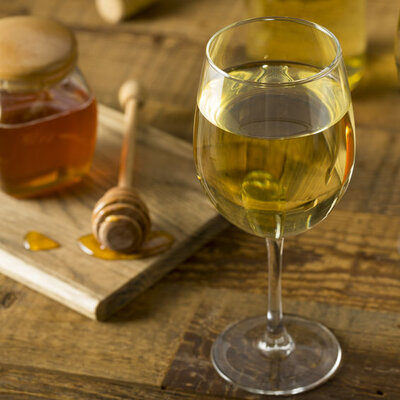
Mead
also known as Honey Wine
What is Mead?
Mead is an alcoholic beverage made by fermenting honey with water. This drink can be flavored with other ingredients like spices, fruits, grains, herbs, and hops. Three major types of mead include: melomel (also known as fruit), traditional, and metheglin (also known as spices and herbs).
- People consume this drink in both sweet and savory dishes.
- Some types of mead are served as a mixer for Martinis and spritzers.
The top ten most popular brands of mead on the market are:
- Lindisfarne
- Mello
- Kinsale
- Friary Honey
- Zalgiris
- Kinsale Atlantic Dry
- Moniack
- Chalice
- Medieval
- Reservoir Black Health
Origin of mead
Honey wine has been around for between 20,000 to 40,000 years and originated in Africa, where it is common to have both heavy rains and extreme droughts. These two extreme weather conditions cause hollows to rot out the crown of Miombo and Baobab trees. In dry periods with no rain, bees come to make their hives in these hollows. During the rainy season, water fills these holes. After a time, the mixture of water, honey, and osmotolerant yeast produces mead. Traditional African tribes took mead from these hollows and much later people left Africa with the knowledge of this new beverage.
Eventually, people learned to make this drink by mixing water and honey in wooden containers and allowing airborne yeasts to do the fermentation. The knowledge of this drink then spread to Asia and Europe. However, urbanization caused the popularity of this beverage to wane, as often only royal people had access to honey. The discovery of sugar from sugar cane also later affected the popularity of honey. Nonetheless, Europe’s monasteries sustained the popularity of mead. Today, commercial producers of this drink use honey, lemons, fresh yeast, and water to make this alcoholic beverage.
Nutrition
A serving size of 2 fluid ounces of mead contains:
- 356 calories
- 40g of carbohydrates
- 0g of protein
- 0g of fat
Mead has some health benefits by virtue of its honey content. First of all, this drink has powerful antimicrobial properties, which can be beneficial for the body. Furthermore, it has significant probiotic content, which may be useful for gut health, if consumed in decent quantities. Nonetheless, as an alcoholic beverage that is high in sugar, it’s best to consume mead responsibly and in moderation.
Commercial production
In 2018, mead’s worldwide market value was $408.45 million and was expected to grow at a rate of 10.41% between 2019 to 2025. The first stage in the commercial production of this drink involves the dilution of honey in water. Depending on the honey wine variant to be produced, the water can be substituted with fruit juice. The type and quantity of honey determine the quality of the mead.
Next, ingredients like citric acid and fruit pulp are added to the drink. After further processing, the honey wine is fermented. Fermentation can take anywhere between several weeks to months. Other post-production techniques like balancing and stabilization are also needed for a good end product. This drink is then left to age for six months to three years before drinking.
Application
The best place to store unopened honey wine is a cool, dry place away from heat and sunlight. An ideal place is a cupboard or pantry. If you want to store this drink after opening it, you can cover it and keep it in the refrigerator. The exact period that mead can be preserved depends on the manufacturer of the drink. Generally, if this drink has a higher alcohol content, it will have a longer shelf life.
Mead recipes
Honey wine adds flavor to both beverages and foods. Here are some popular recipes:
FDA Regulation
The Alcohol and Tobacco Tax and Trade Bureau (TTB) primarily regulates the production of honey wine. According to the Federal Alcohol Administration Act, honey wine is defined as a drink produced wholly from honey except for water, sugar, or added alcohol. If you want to import honey wine with an alcohol content between 0.5% and 7%, you are to label the wine according to the FDA’s food labeling requirements. Also, if you want to produce this drink for commercial purposes, you need a permit from the TTB.
References
Field, Colin. “A Beginner’s Guide to Drinking Mead.” Cottage Life, Blue Ant Media, 12 June 2017, cottagelife.com/entertaining/a-beginners-guide-to-drinking-mead/.
Hill, Ansley. “What Is Mead, and Is It Good for You?” Healthline, Healthline Media, 15 Nov. 2018, https://www.healthline.com/nutrition/mead#pitfalls
Bugher, Tim. “TTB: FAQs: Alcohol.” www.ttb.gov, Alcohol and Tobacco and Trade Bureau, 25 Sept. 2020, https://www.ttb.gov/faqs/alcohol#hw
